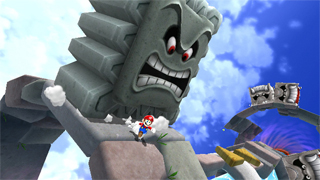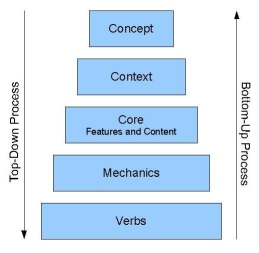Top Ten badass weapons
Gaming site Ripten compiled a list of the top 10 videogame weapons, similar to the one by GameTrailers but a lot of good games have been released since then, and you can approach this issue from so many angles. While not being particularly original Ripten at least had some amusing descriptions.
“While not exactly an instrument of finesse, the Gravity Hammer was perfectly designed for blunt force trauma. Have a room full of elites that needs eradicating? Use the Hammer. A co-worker parked his warthog in your parking space? Use the Hammer. Can’t open that pesky jar of preservatives? Employ the Hammer. The Brute Gravity Hammer follows the ethos of the “if it ain’t broke, break it” variety. And it does this very well”
… and no, I wouldn’t have written this if the Darkness wasn’t number 2 on the list.
Half-Life 2 + Episode 1 + Episode 2

Getting through Half-Life 2 didn’t take as long as I had originally feared; the nausea settled after awhile and episodes 1+2 only took roughly half as long to blast through as the original did. Apart from a slightly refined level design, I don’t think the series evolves too much over these three games, so I’ll simply treat it as a single game. I will say that it could well have evolved more during the episodes since they spent so much time on them, though.
Half-Life was a breakthrough in FPS design, mostly due to the prerecorded sequences of the story occuring withouth removing control from the player, and the story this allowed for. I was already bored with FPS games by then, and my friend showing me some scientist getting pulled into a crack in the wall wasn’t enough to convince me that it was worth playing. Half-Life 2 has reportedly done similar groundbreaking things, and I have to admit it does very many pretty new things very well, although I don’t have the time or energy to find out which ones it actually did first. It doesn’t matter anyway, except for providing an explanation to why it would be considered one of the greatest games of all time.
Now, I liked Half-Life 2. Mainly for the same reasons I like most of Halo; the gameplay is streamlined for a good experience. Levels are just long enough not to become boring, the difficulty is set just right and there aren’t any really frustrating problems to solve – you really can tell that many hours of playtesting went into this game. I also thought the story was good, even though the presentation of it had some embarrassing dips in every part.
It is kind of difficult to come up with an extended opinion about a game that is so iconic – thought it gives me some theories about why people dislike Halo. Halo has a better AI, Half-Life has a more coherent story and setting but both are very well-balanced, polished games that don’t seem out-of-the-ordinary or special unless you played them when they first came out.
10 years of Ernest Adams

Ernest Adams lists some of the highlights in well-designed games during the last 10 years as it is the 10th anniversary for his column “the Designer’s Notebook”. Nothing really new or surprising if you have been keeping up during the last 10 years, but a good compilation if you feel you missed a few.
On franchises and Metroid
A week ago, Gamasutra had a story about maintaining a popular franchise. I didn’t bother linking to it then, because even though it was well-written (as most Gamasutra articles are), it was sort of a long rant for reaching an obvious point that written for gamasutra was more or less preaching to the choir anyway. It did bring up the issue of Metroid, however, and I’d like to expand on that on a personal level.
Super Metroid was released 1994 and was the last Metroid seen for 8 years – meaning it skipped the N64 generation completely. Before that, only a single Metroid game had been released to each of the three Nintendo consoles, so it didn’t seem like Nintendo would make them just to milk the franchise. Series mastermind Gunpei Yokoi had long since left Nintendo (and, sadly, died in a car accident shortly after), so when Nintendo revealed that they would be creating the new Metroid as a first-person 3D game, a lot of fans got kinda angry, as said article points out.
Metroid Prime was generally thought of a digital masterpiece (and subsequently led to Nintendo milking the franchise a whole lot more than they had previously), and though it took me awhile to admit, I personally believe it was one of the very few games where a great original concept was actually improved when converted to 3D. Simply enough, Metroid Prime wasn’t just a better game than Super Metroid was, it did the “Super Metroid thing” better than Super Metroid did.
Of course, some people don’t agree with me on this and think it sucks – I’d like to think that most of those haven’t played the game. I instinctively want to quiet voices saying “well, Metroid is supposed to be 2D” by quoting Nintendo and saying that if anyone has the right to decide, it’s them, but – arguing about such things being childish aside – it isn’t really correct either way.
First of all, I know that I have been like that – still am, in some respects, and having things to dislike isn’t all bad. Second – and countless designers have already said this – the game medium is unique in the way that the creator and the player create the experience together; if there is no player, there is no game taking place. Metroid is about exploration for me, and if it had all been a bunch of linearly laid-out levels with no secrets, it wouldn’t have been Metroid even if it took all of the graphics, sounds and objects from earlier games – I guess you can argue in a similar way about dimensionality. This sort of explains why the tone in game discussions is often so rabid, since your own input means so much when playing you might as well be posting about different games. But that’s a bigger topic altogether.
It occurs to me know that most of the articles I link to come from Gamasutra. I read other feeds as well, but Gamasutra has a lot more features that are insightful enough to remember. And I just didn’t want to rant about Jeff Minter only to point out that another visionary faced the internet and lost it when I could simply say so in a sentence at the end of a real post.
On neglect
There has been a lot of talk about game addiction lately, mostly due to the kid who was forced into rehab because of his neglecting interest in the “real world”.
Now, I really didn’t want to comment on this because even though I believe games were just the outlet for a bigger problem, the kid obviously had problems of some kind and having social services stepping in was most likely the right thing to do. If I blame media and interest groups for scaremongering in order to push an agenda or sell issues, trying to push an agenda of my own by trivializing a real problem would be hypocrisy.
That being said, Swedish reporter Peter Ottsjö wrote a nice summary of why misplacing the blame might actually harm the people you were trying to help in the first place, and it is certainly worth a read.
Super Mario Galaxy

A couple of days ago, I had a discussion with a coworker about how one could implement the flash-game Fold in a 3D – environment, though it is clear to me now that Super Mario Galaxy both shows the idea works brilliantly and, in a way, makes such a game superfluous. Gravity puzzles are present in most platformers coming from the school of Mario, but to my knowledge this is the first big game created entirely around them. In a way this is weird, Galaxy probably could’ve been made just as good on the GameCube since the Wiimote-specific controls are few and kinda tacked on. Saying that Nintendo uses a concept that doesn’t abuse motion controls isn’t really an insult, though.
Besides from the space-and-gravity- theme, Galaxy contains what Super Mario 64 had back then; great level design both visual- and game-design wise, tight controls and scalable varying gameplay. This autumn has seen a lot of high-quality releases and this is no exception, so I’ll go right ahead and start nitpicking.
My biggest (and really, only valid) complaint is the camera/controls. The camera usually moves by itself, sometimes you can interfere and sometimes it is locked – problem is, you can’t stop it from moving and you have very limited control of it. There are several reasons for this, but since the controls are locked to the camera you kind of lose touch when it suddenly decides to swing around. This becomes especially frustrating underwater – which brings me to my second gripe, the scalability.
Galaxy has a lot of really frustrating moments, time-attack levels and tricky minigames; problems range from long levels devoid of checkpoints and dodgy exercises with the wiimote to repetitive boss-fights and struggling with the aformentioned camera. You can’t really argue that these are unfair though, since you don’t have to complete them in order to finish the game, and I guess having some extra material for people with a taste for challenges is a good thing. Besides, it can’t have been that difficult since I got most of the stars over 2 days.
All in all, Super Mario Galaxy is an improvement in much the same way as Super Mario 64 was (and Sunshine wasn’t), and it seems I can’t write something even remotely interesting about it so I guess I’ll stop trying.
Ratchet & Clank Future

It occurs to me that I’ve spent the last few reflections bitching at perfectly good games for no other reason than that I was weary of the hype surrounding them (or in the case of Metroid, because I had inhumane expectations), luckily I hadn’t read anything about Ratchet & Clank before I played it, neither have I played any other of the Ratchet & Clank games. It also occurs to me that I’ve called several games “the best single-player experience on the system…”, I blame it on the recent generation shift (which makes saying it in the first place pointless), and I won’t say it for Ratchet & Clank since the only other PS3 game I’ve really played is Resistance, in co-op. Ah, who am I kidding, I don’t need to defend my reasoning.
Ratchet & Clank stem from the time when platform games with adventure duos was popular and games like “Banjo Kazooie” and “Jak & Daxter” were taking names (yeah, it wasn’t that many and they were far apart, but that’s what they said at the time – don’t blame me for unimaginative journalists). These were a new breed of platform games developed solely for high-end 3D platforms, which brought them advantages which I’ll get to in a bit.
Ratchet & Clank is all about the gadgets and weapons, not entirely unlike megaman but with more open gameplay and a quirky style that I guess is what we would get if Pixar made a Futurama movie. The anthropomorphic rodent Ratchet and his Robot/backpack Clank unravels a story about an invasion, Ratchet’s unknown origins and a secret superweapon as they travel between planets in said pixar-futurama-ish sci-fi setting. Not much to say about it really.
The duo was created in the PS2 era, as such it never had to deal with the painful transformation from 2D to 3D – and it shows. The game design of Ratchet & Clank is incredibly polished – levels are varied and interesting, for every weapon there is a right and a wrong target, controls work as they should and the parts with “special” gameplay are easy enough to be passable but not so easy that they feel pointless. In short, you’re very seldom frustrated with Ratchet & Clank, for me it only happened during those rare times when savepoints were spaced too far apart – you can’t really invite to exploration and then force the player to replay half the level when s/he tries to jump over a seemingly passable chasm. It’s like you want to mail a copy to everyone in Sonic team as a visual aid – this is how 3D platform games should be done.
It seems funny that the only real gripe I have with Tools of Destruction is the number of bugs. Now, of course I’m a developer and used to looking for them so I might either notice more or be more bothered by them than the average player. However, these aren’t just cosmetic bugs – it has that too – but real showstoppers. At one part, the game simply crashed for me and I had to hard-reboot it, at another I was caught in a dialog that wouldn’t disappear and wouldn’t let me move, and all over the game I kept falling through solid objects. Close to the end of the game, this happened some 2 or 3 times in the same general area – these kinds of bugs wouldn’t bother me so much if I didn’t know they would be easy to fix.
Still a good game though, and a nice build-up for Mario Galaxy that I’m going to play this weekend.
Game Design Cognition

Gamasutra has a piece entitled Game Design Cognition: The Bottom-Up And Top-Down Approaches, describing an abstract view of two different thought-processes used to create game designs and how they differ from each other. As I am a sucker for abstraction and mapping design processes into patterns, I really liked this piece.
DivX, continued
A forthcoming system update for the PlayStation 3 will allow users to play back DivX-encoded video files, DivX, Inc. has announced.
No specific date was provided as to when consumers can expect to receive DivX functionality. Developers are currently able to make use of the technology care of the latest PS3 software development kit, version 2.00 of which was released November 2.
“We are excited to work with Sony Computer Entertainment to bring DivX to PS3,” said DivX CEO Kevin Hell. “Our technology will expand the multimedia functionality of PS3 by enabling users to enjoy access to the broad library of content in the DivX digital media format.”
… So that’s why.
DivX possibly for 360
Seems like DivX and Microsoft have been talking about it, at least. Well, I don’t plan on using it but it’s a start…
Hell seemed initially enthusiastic, then backed off: “Yes! that, uh, we’re in discussions with Microsoft on that at this point in time, so I can’t go into any great detail on that. Um, that is not a certified, that is not a certified or licensed product at this time.”
http://www.gamasutra.com/php-bin/news_index.php?story=16206
Microsoft original reason for not including DivX or XVid support was that “most of the available material is pirated” … Well, they’re just codecs but I’m not going to pretend that the fact that they’re probably right doesn’t mean anything; they would be hard-pressed to make any immediate money off the deal and it might’ve put them in a bad place when negotiating other deals. Waiting until they had a solid install base and leverage was probably the financially sane thing to do.
That being said, it really bothers me when companies throw away the better solution because piracy has somehow tainted it; just a few weeks ago we saw RIAA & co shut down OiNK and repeat the dreaded mistake of some 5 years ago. I’m not saying they should just’ve let it slide, but now they’re just gathering bad press for shutting down a site that was better than anything they’ve ever come up with, and twenty new, more hard-to-get trackers will appear as a result – just like when Napster was shut down and paved way for GNUtella, DC and KaZaa. I’m getting really off-topic (making up for my lack of post when OiNK actually went down), so I’ll conclude with the words of Rob Sheridan;
“I used to reject the wishy-washy “music should be free!” mantra of online music thieves. I knew too much about the intricacies and economics of it, of the rock-and-a-hard-place situation many artists were in with their labels. I thought there were plenty of new ways to sell music that would be fair to all parties involved. But I no longer believe that, because the squabbling, backwards, greedy, ownership-obsessed major labels will never let it happen, and that’s more clear to me now than ever. So maybe music has to be free.”